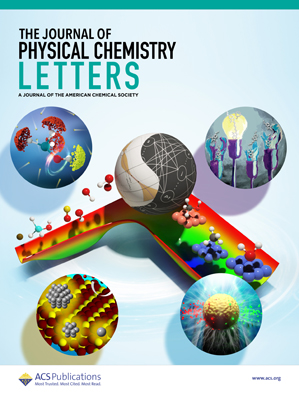Excited State Dynamics Govern Emission Properties of Unique Silsesquioxane-Salphen-Based Zinc Compounds
IF 4.6
2区 化学
Q2 CHEMISTRY, PHYSICAL
引用次数: 0
Abstract
This study aims to develop a synthetic protocol for preparing salphen-based hybrid compounds with silsesquioxane T8 cages anchored at the molecule’s periphery. Three types of coordination compounds featuring κ4-N2O2-donating atoms were obtained via a sequence of reactions. These compounds differ in the arene linker between the salphen and silsesquioxane fragments. An individual synthetic pathway was developed for the preparation of aldehydes, followed by a tailored strategy for the synthesis of the final complexes employing both solution-based and mechanochemical methods in the solid state. The latter represents a novel technique in silsesquioxane chemistry. The newly designed ligands were used for the coordination of Zn2+ ions to evaluate their ligation properties and to determine the photophysical properties of the resulting complexes in comparison to their bare ligand molecules. Using absorption and emission spectroscopy, combined with advanced time-resolved spectroscopic methods, we demonstrated that the photochemical efficiency of these compounds is influenced by their tendency to aggregate in solution, which positively affects their photophysical properties and enhances their potential for photodynamic therapy (PDT). Additionally, we explored the ability of these complexes to generate singlet oxygen (1O2) depending on the architecture of the designed ligands. The results indicate that the excited state dynamics plays a crucial role in determining the emission properties of the studied compounds, which may have significant implications for their applications in medicine and materials science.

激发态动力学控制独特的银倍半氧烷-沙芬基锌化合物的发射特性
本研究旨在开发一种合成方案,用于制备基于沙芬的杂化化合物,并将硅氧烷T8笼固定在分子的外围。通过一系列反应得到了三种以κ4- n2o2为供原子的配位化合物。这些化合物的不同之处在于萨尔芬和硅氧烷片段之间的芳烃连接。开发了一种单独的合成途径来制备醛,然后采用基于溶液和机械化学的方法在固态下合成最终的配合物。后者代表了一种新的硅氧烷化学技术。新设计的配体用于Zn2+离子的配位,以评估其连接特性,并确定所得到的配合物与裸配体分子的光物理特性。利用吸收和发射光谱,结合先进的时间分辨光谱方法,我们证明了这些化合物的光化学效率受到它们在溶液中聚集的倾向的影响,这对它们的光物理性质产生了积极的影响,并增强了它们光动力治疗(PDT)的潜力。此外,我们探索了这些配合物产生单线态氧(1O2)的能力,这取决于所设计的配体的结构。结果表明,激发态动力学在决定所研究化合物的发射特性方面起着至关重要的作用,这可能对其在医学和材料科学中的应用具有重要意义。
本文章由计算机程序翻译,如有差异,请以英文原文为准。
求助全文
约1分钟内获得全文
求助全文
来源期刊

The Journal of Physical Chemistry Letters
CHEMISTRY, PHYSICAL-NANOSCIENCE & NANOTECHNOLOGY
CiteScore
9.60
自引率
7.00%
发文量
1519
审稿时长
1.6 months
期刊介绍:
The Journal of Physical Chemistry (JPC) Letters is devoted to reporting new and original experimental and theoretical basic research of interest to physical chemists, biophysical chemists, chemical physicists, physicists, material scientists, and engineers. An important criterion for acceptance is that the paper reports a significant scientific advance and/or physical insight such that rapid publication is essential. Two issues of JPC Letters are published each month.
 求助内容:
求助内容: 应助结果提醒方式:
应助结果提醒方式:


